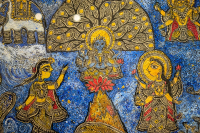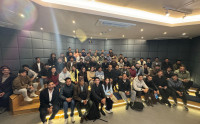Culture & Lifestyle
Plight of digital artists against copyright infringement
Most digital artists prefer to name and shame businesses who use digital artwork without permission in social media instead of pursuing legal action against copyright infringement.
Shranup Tandukar
In 2019, Diwas Maharjan, a graphic designer who works at Hamro Patro, created an artwork relating to Indra Jatra in his free time. He had allowed Hamro Patro to use the artwork for their Indra Jatra post. The artwork was copied and used without permission by other businesses such as a biryani house, a cafe and even a well-known two-wheeler brand, says Diwas.
Nepali digital artists, along with Designers’ Community Nepal, a public Facebook page for graphic designers in Nepal, were able to raise a collective voice against the case of copyright infringement in September 2021.
“Some of the companies admitted their mistake and deleted their posts,” said Diwas. “However, one of the businesses responded rudely and instead became confrontational. They finally deleted the image only when they received huge social media backlash.”
Diwas says that he didn’t pursue legal action against the infringers because he didn’t have enough knowledge about the copyright protection acts in Nepal. He says that even when he got to know about the Copyright Act and punishment for copyright infringment, “the process seemed too long and tedious.”
“I only wanted a proper apology and credit for my artworks,” he said.
The issue of copyright infringement of digital artwork gains traction on social media time and time again when notable businesses use artworks without permission from the artists.
In a recent case, Sunil Garbuja received a private message from his friend on January 1, 2022, informing him that apparently one of his artworks had been used without his permission. In the days that followed, he received even more messages from his friends that multiple different businesses were using his artwork without his knowledge.
Garbuja, an illustrator and graphic designer based in Australia, had created an Instagram page named ‘KreativeKira’ in 2017 to showcase his digital artworks. On the same Instagram page, he had posted an artwork titled ‘Kauda’ depicting a male and female in traditional Magar attire on March 24, 2019. He had also posted three timelapse videos illustrating the making of the ‘Kauda’ artwork in the following days.
However, on December 30, 2021, eSewa posted an almost identical artwork to the ‘Kauda’ artwork on the occasion of Tamu Lhosar without any attribution to Garbuja. When Garbuja messaged the official Facebook page of eSewa, he says that eSewa replied, “fairly quickly but carelessly.”
“They didn’t read the issue I was addressing, and responded with a cookie-cutter, copy/paste response related to payment transaction issue,” he said. “The next day, they took down the offending post, and then apologised via DM.”
While Garbuja is happy that eSewa at least acknowledged their mistake and took down their posts, he is unsure if that is enough reparation.
“While the post was up, hundreds, if not thousands, of people saw my artwork without knowing that I had made it. The damage had already been done,” said Garbuja.
In Nepal, the Copyright Act, 2059 (2002) provides copyright protection to original artworks and punishment for copyright infringement. However, since the Copyright Act was made almost 20 years ago and has been amended only once in 2004, it is woefully ill-equipped to deal with copyright protection in today’s digital world.
The digital artists the Post spoke to also say that they feel that the legal provision for copyright protection is too complex and that they would rather not pursue legal action against copyright infringement.
Nepal Copyright Registrar Office in Bhimsengola of Kathmandu is the authority tasked with handling all copyright-related issues.
Registering an artwork requires submitting an application to the Registrar Office by the author along with proof of ownership and an application fee of Rs 100. After the application, the author of the work needs to convince the registrar and concerned officials of the originality, creativity, and authorship of the work. The whole process of registration can take anywhere between one week to one month.
According to the statistics given by the Nepal Copyright Registrar Office, from July/August 2016 to June/July 2021, 17 works under ‘Art/Painting’ have been registered. Whereas from July/August 2021 to November/December 2021, only one work under ‘Art/Painting’ has been registered. In total, from July/August 2004 to November/December 2021, only 2,166 copyright registrations have been successful.
While Section 5 of the Copyright Act states that “registration of a work, sound recording, performance or broadcasting shall not be required to acquire the right under this Act,” artists are advised to register their work for copyright protection if they intend to pursue legal action against copyright infringement.
Kumar Silwal, an associate at Sinha Verma Law Concern, says, “In theory, all works are given copyright protection without registration as stated by Section 5 of the Copyright Act. However, we still advise authors to register their artwork to make their infringement cases strong when they go to court.”
But registering digital artwork can be easier said than done. Section 2(a) of the Act defines the word ‘work’ as “any work presented originally and intellectually in the field of literature, art and science.” However, it does not specify digital art in the definition of ‘work’, so digital artists have difficulty registering their digital artwork for copyright protection.
Bigyan Prajapati, a graphic designer and digital artist, says that the process of registering digital artwork is unfeasible. He created the iconic characters of Baucha O Maicha, two fictional Newa characters. Since other third parties started using his characters as t-shirt designs without his permission, he attempted to register his artwork for copyright protection.
“When I went to the Registrar Office to copyright my characters, I was told that I couldn’t register the characters themselves but only specific artworks,” said Prajapati. “And as I had created almost 200 different artworks featuring Baucha O Maicha, registering all of them was not financially feasible.”
As an alternative, Prajapati was advised to trademark his characters. However, since trademarks are only given to businesses, he had to establish a business and then only was he able to trademark his ‘Baucha O Maicha’ characters.
Copyright infringement has also been classified as a criminal offence instead of a civil offence which means that the copyright infringement cases are offences against the state and carry imprisonment punishment.
Section 27 of the Act states that in cases where any person infringes protected rights, “such a person shall be punished with a fine of a sum from ten thousand to one hundred thousand rupees or with imprisonment for a term not exceeding six months or both [for the first offence].”
Priyanjana Bhattarai, who founded Kala Legal, a law firm specialising on IP (Intellectual Property) protection, says, “While copyright infringement being a criminal offence creates fear among the infringers since the punishment for infringement includes imprisonment, the downside is that artists have to file an FIR and begin a lengthy court procedure against the infringers.”
The lengthy process for compensation and the fact that artists have to file an FIR has led to most artists preferring not to take legal action and instead preferring to raise their voice on social media against copyright infringers. In cases of copyright infringement in Nepal, the onus is on artists to inform businesses that they are using copyrighted artwork and images and to ask them to delete the concerned artwork and images.
When businesses receive backlash for using copyrighted artwork, most of them simply issue a private apology and take down their social media posts. Artists rarely receive financial compensation for the illegal use of their artworks.
Ananda Maharjan, a graphic and type designer who is the creative head at Hamro Patro, has had some instances where his typefaces, artworks, and photos were used without his permission or knowledge. He would simply message the copyright infringers to delete the copyrighted artworks and pictures, he said.
Recently, when one of his typefaces was used without his permission, he received financial compensation just because the business wanted to keep using the typeface, so he reached an agreement with the business.
“Normally, these cases of copyright infringement are done by junior designers or inexperienced digital marketing agencies,” said Ananda. “Most businesses and even digital marketing agencies are not aware of copyright protection and its legal provisions in Nepal.”
However, there are positive changes around the corner as IP protection garners increased attention in Nepal. Bhattarai, who founded Kala Legal considering the recent explosion of interest and investment in digital art, says there is no doubt that copyright protection needs more attention in Nepal, and artists also need to be aware of the different IP protection laws prevalent in Nepal.
The draft bill to amend the Copyright Act, known as the First Amendment to the Copyright Act 2059, was announced in early 2020 but hasn’t been passed yet.
Bhattarai says that while the bill may not be completely inclusive and is still a bit behind in times, it is a step in the right direction.
“The bill has expanded upon the definition of ‘work’ to include more creative works like translation, any work in 3D, mobile apps, etc.,” says Bhattarai. “While the bill still does not address the damage calculation aspect of financial compensation, the fine provided by Section 27 has been proposed to be increased to Rs 20,000 to Rs 200,000 from Rs 10,000 to Rs 100,000 for the first offence.”




 14.83°C Kathmandu
14.83°C Kathmandu















